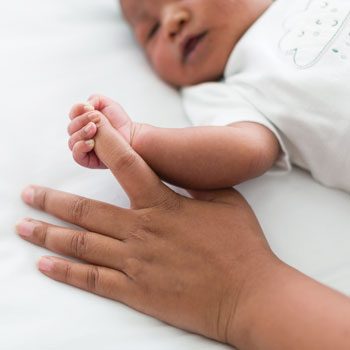Finding a prescription for housing instability
Safe and affordable housing is essential to health and ACP has a policy paper offering several recommendations aimed at physicians, policymakers, and payers.
Homelessness and housing instability in the U.S. are increasingly being recognized as taking a toll on physical and mental health. ACP recently issued a new position paper calling on physicians and policymakers to address this crisis, working simultaneously on the medical needs of patients with unstable housing and the lack of affordable housing in America.
More than 650,000 individuals in the United States were experiencing homelessness on a single night in January 2023, with 39% staying in unsheltered locations, according to data from the U.S. Department of Housing and Urban Development. Meanwhile, housing instability impacts even more people across the United States. In 2019, more than 17.6 million households spent more than half of their income on housing, leaving them at risk for eviction or foreclosure, according to a report from the Joint Center for Housing Studies at Harvard University in Cambridge, Mass.

ACP's position paper, published by Annals of Internal Medicine on Feb. 27, highlights the "cyclical relationship" between health and housing access. Although housing instability and homelessness have the same origins and produce some of the same health concerns, individuals without stable housing may face challenges like trouble paying rent, overcrowding, frequent moving, or spending the bulk of household income on housing, the authors explained. In comparison, they defined persons experiencing homelessness as those who "lack a fixed, regular, and adequate nighttime residence," per the U.S. government's definition.
"Poor health begets homelessness, whether it's from medical debt or a massive medical event that causes job loss and financial insecurity leading to housing loss," said Caitlin Ryus, MD, MPH, assistant professor in the department of emergency medicine at Yale University in New Haven, Conn. "Once you've gone down this spiral and ended up unhoused, that itself is a traumatic event and is incredibly destabilizing. It's like a riptide for any chronic medical conditions that you are managing that makes it really hard for you to maintain your health. It's an incredibly vulnerable population with a very unique set of challenges from a health perspective."
Achieving universal housing access
ACP asserted in its position paper that access to safe and affordable housing is essential to health and offered several recommendations aimed at physicians, policymakers, and payers. Tackling housing instability felt like the "next logical step," said Josh Serchen, Senior Associate for Health Policy at ACP and a coauthor of the position paper.
ACP recommends that policymakers take the following actions:
- Prioritize affordable housing and work to address the underlying drivers of homelessness;
- Provide adequate funding for programs that meet the immediate health care and shelter needs for unhoused individuals;
- Enact laws and regulations that decriminalize the symptoms of homelessness and housing instability;
- Sufficiently fund a long-term national strategy to address homelessness that reflects local conditions, including supporting additional research on intervention and analysis of predictive causes of homelessness; and
- Implement and evaluate Medicare and Medicaid demonstration projects that offer housing support and targeted medical services to individuals who are unhoused or at risk of losing housing.
ACP urges public and private payers to reimburse for health care services delivered to unhoused patients. On the care delivery side, the ACP position paper recommends that information on the underlying individual and structural issues related to homelessness and housing-based health inequities be incorporated into medical education at all levels. ACP also called on physicians and other health care professionals to learn how to perform screening for homelessness and housing instability and to understand how to treat the unique health needs of this population.
"There's a responsibility on physicians to educate themselves, to be conducting these screenings, and to be connecting patients to resources. But we also recognize that physicians can't do this on their own and there needs to be adequate support to undertake this work," Mr. Serchen said.
Signs of housing instability
Homelessness or housing instability is not always obvious to clinicians. But there may be administrative indicators that could alert physicians to follow up, such as frequent address changes or giving addresses associated with known shelters or even the hospital itself, according to Dr. Ryus, who is also director of the Yale ED Homelessness Task Force.
Patients who are currently unhoused and struggling to afford rent may stop filling their prescriptions or start skipping appointments because of cost concerns, explained Katherine L. Chen, MD, PhD, assistant professor of medicine in the division of general internal medicine and health services research at the David Geffen School of Medicine at UCLA. The stress of an unstable living situation can also present as changes to weight, blood pressure, and trouble sleeping. "There's lot of different aspects of medical care where we might start to see signs or symptoms that could raise alarms to probe more," she said.
Some health care systems include questions about housing in screening questionnaires on social determinants of health. In that case, Dr. Chen advises clinicians to be aware of what those questions are and how the patient has responded. If the question isn't being asked in a standardized way, try to raise it at least annually, she said.
The most important thing is to ask the patient rather than to make assumptions, Dr. Ryus said.
"Asking is the best way, rather than relying on nonverbal cues or appearance or stereotypes, because there's a lot of invisible homelessness out there," Dr. Ryus said. "Either through formal screening tools—if your practice or institution has implemented this—or just by asking during the social history, asking directly destigmatizes homelessness within the health care system and normalizes conversations around housing."
Talking to patients without judgment is also key, Dr. Chen said. She will ask patients, "What's your living situation?" In cases where she knows that the patient has experienced housing insecurity in the past, she will ask, "Where have you been staying?"
"It's a question that there's an answer to whether you are housed at the time or not," Dr. Chen said. "It doesn't create an opportunity to feel excluded by the question of 'Where do you live?' which sometimes assumes a more permanent housing situation."
While finding time to discuss a patient's housing can be challenging in the context of a short visit, Dr. Ryus said it matters because it can change how health issues are managed. For instance, it is essential to know if a patient doesn't have a safe place to store medications or if someone with a limb injury needs to walk a lot because they are unhoused.
"Keep in mind that these same questions are not just for your unhoused patients. They can open up insights into the lived experience of your housed patients who might just need support too. I ask a lot about the home environment, mobility, company, support, and access to transportation," Dr. Ryus said. "When we get to housing and someone says that they're homeless, I'll ask more details about that."
Team approach
MaryCatherine Arbour, MD, MPH, medical director of the social care team at Brigham and Women's Hospital's Center of Excellence for Primary Care, said her hospital screens every Medicaid patient for health-related social needs, including housing stability. She estimates that the 14 primary care clinics in the system make 200 to 300 housing-related referrals per month, but only about a third of those result from screening.
"The rest of them come because patients come in to see their doctor, they come into the clinic, they talk with the secretary or with other members of the care team, and they say, 'I'm going to be homeless; can you help me?'"
Since 2018, Brigham and Women's Hospital has built a housing program to provide support for patients who are identified as housing insecure. The hospital employs community resource specialists who identify and triage social needs among patients, including housing. They also have housing specialists who can link patients to community programs, based on their specific needs and eligibility, as well as partnerships with local legal groups who can provide representation for patients in housing court.
However, the program does not have the resources to serve all patients in need, Dr. Arbour said. Instead, they prioritize patients who are currently experiencing homelessness and who are at imminent risk of eviction, meaning they have a written notice of eviction or a court date. "We do not provide intensive support to patients who are stably housed," she said.
Participation in the program has been successful in reducing health care usage and improving health status. Dr. Arbour and her colleagues conducted a retrospective cohort study of 1,139 patients in the program between 2018 and 2021 and found that participation was associated with 2.5 fewer primary care visits and 3.6 fewer outpatient visits (including behavioral health, psychiatry, social work, and urgent care) annually. The study was published in the February Health Affairs.
Many patients reported improvements in their health. Some patients who were able make a change in their housing attribute those improvements to eliminating allergens or mobility obstacles, for example. In addition, patients who did not move reported mental health improvements that they attributed to the empathy and respect they received from housing advocates in the program.
While the Brigham and Women's program is unique, Dr. Arbour said there are some simple steps that physicians can take to help patients with homelessness and housing instability gain access to housing. For patients who are experiencing homelessness, ask where they have been sleeping and document it in the clinical note. This can help patients demonstrate that they have been homeless for a certain period of time and allow them to access emergency shelter.
"They have to have documented homelessness and often somebody who is experiencing homelessness doesn't have a lot of documentation," Dr. Arbour said.
Similarly, physicians can document when a patient is staying somewhere that is exacerbating an underlying health condition, such as asthma or post-traumatic stress disorder. That type of documentation can give the patient priority in a housing lottery, she explained.
Dr. Arbour also advised physicians to lean on their social work and case manager colleagues to help connect patients to local resources. Working with the housing specialists at her institution has taught her a lot about the bureaucracy patients are up against when they have unstable housing, she said.




